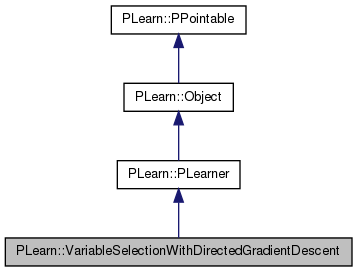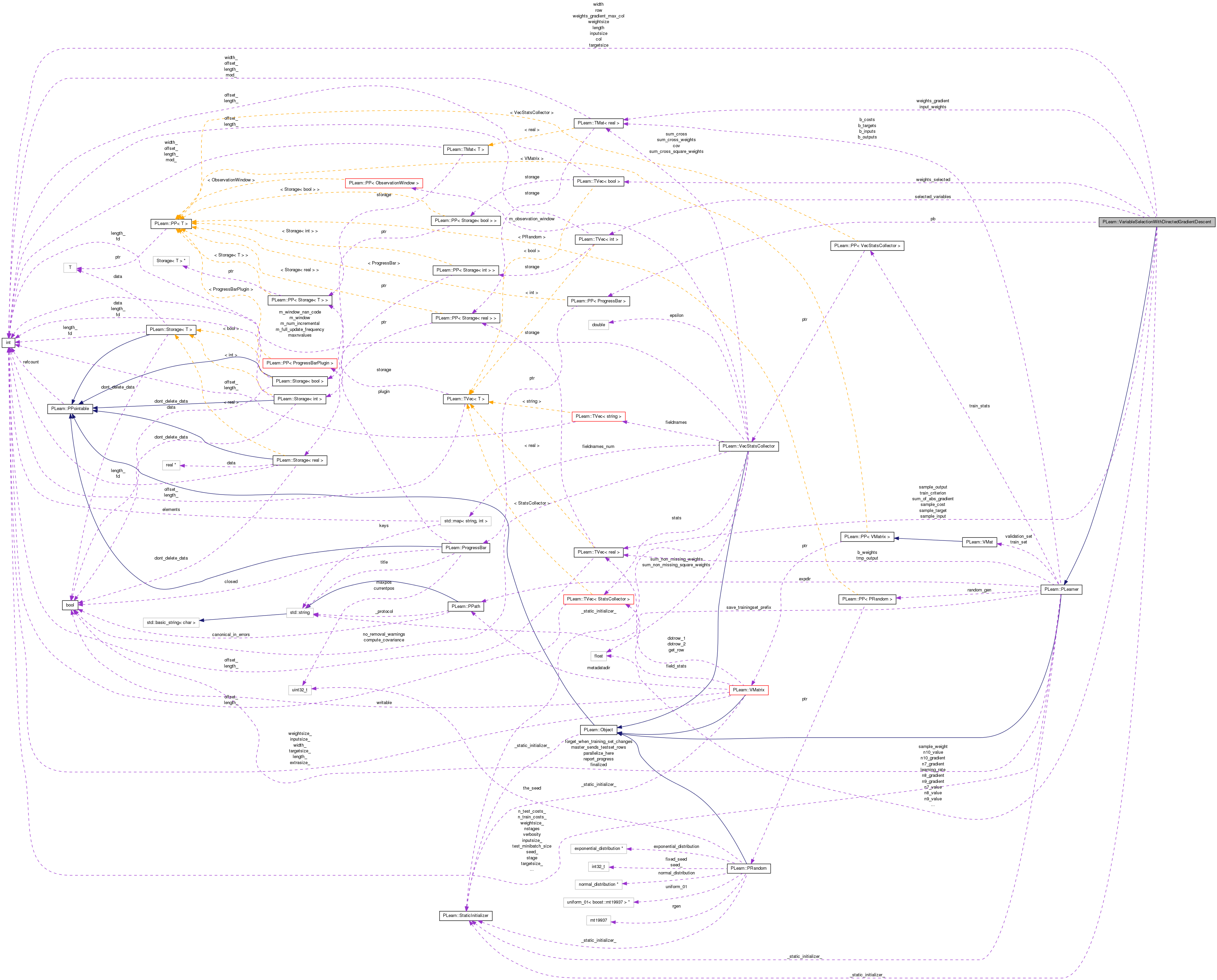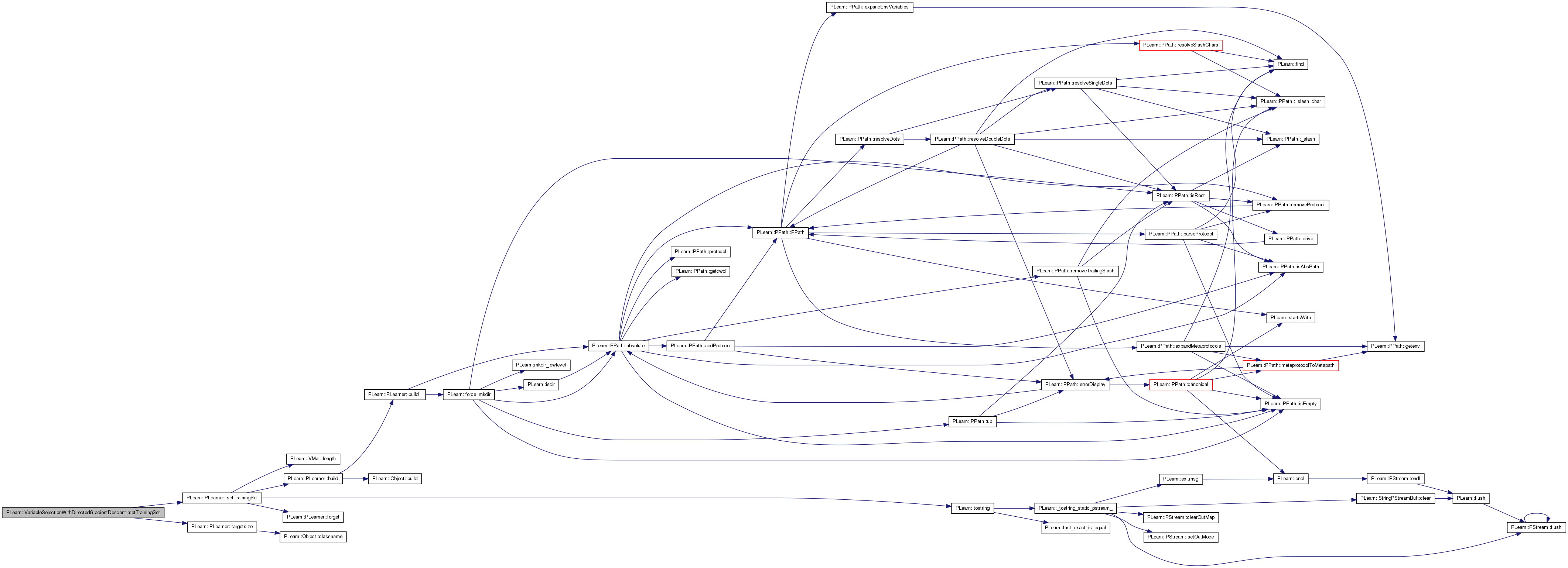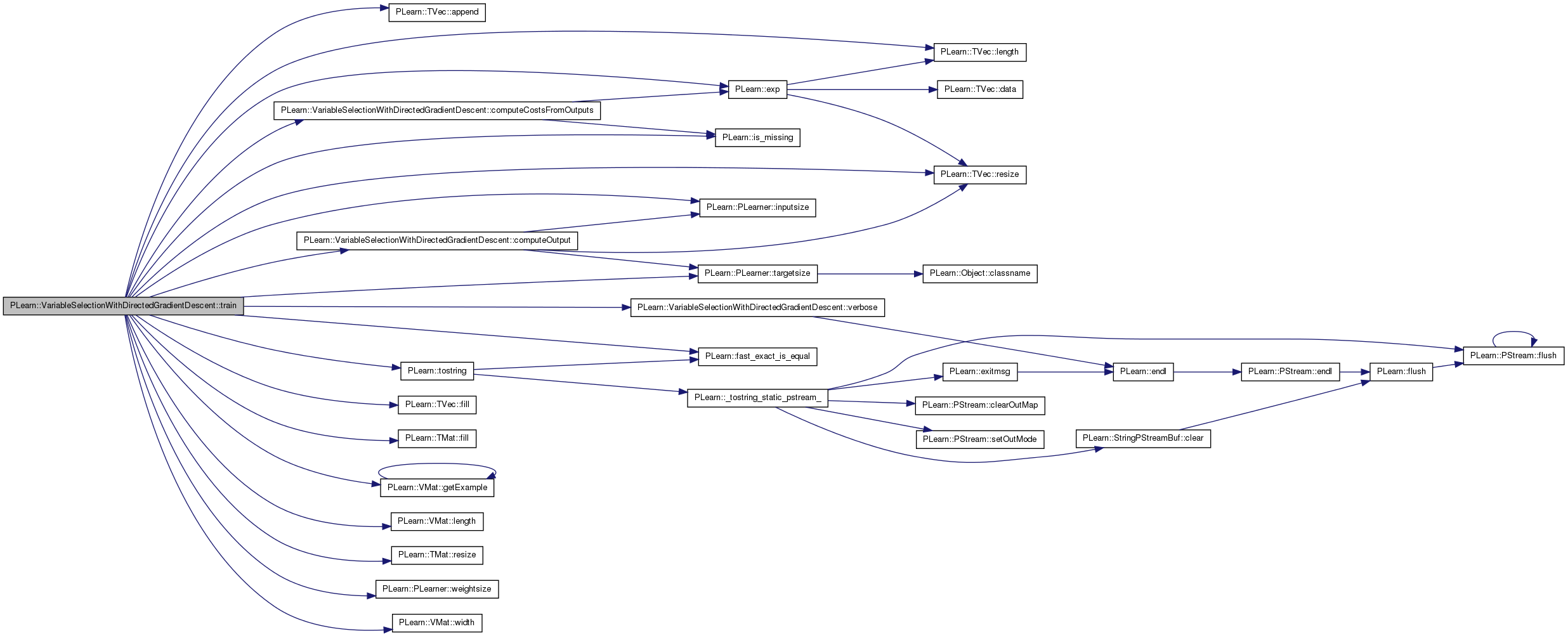|
PLearn 0.1
|
|
PLearn 0.1
|
#include <VariableSelectionWithDirectedGradientDescent.h>


Public Member Functions | |
| VariableSelectionWithDirectedGradientDescent () | |
| Default constructor. | |
| virtual string | classname () const |
| virtual OptionList & | getOptionList () const |
| virtual OptionMap & | getOptionMap () const |
| virtual RemoteMethodMap & | getRemoteMethodMap () const |
| virtual VariableSelectionWithDirectedGradientDescent * | deepCopy (CopiesMap &copies) const |
| virtual void | makeDeepCopyFromShallowCopy (CopiesMap &copies) |
| Transforms a shallow copy into a deep copy. | |
| virtual void | build () |
| Finish building the object; just call inherited::build followed by build_() | |
| virtual void | train () |
| *** SUBCLASS WRITING: *** | |
| virtual void | forget () |
| *** SUBCLASS WRITING: *** | |
| virtual int | outputsize () const |
| SUBCLASS WRITING: override this so that it returns the size of this learner's output, as a function of its inputsize(), targetsize() and set options. | |
| virtual TVec< string > | getTrainCostNames () const |
| *** SUBCLASS WRITING: *** | |
| virtual TVec< string > | getTestCostNames () const |
| *** SUBCLASS WRITING: *** | |
| virtual void | computeOutput (const Vec &input, Vec &output) const |
| *** SUBCLASS WRITING: *** | |
| virtual void | computeCostsFromOutputs (const Vec &input, const Vec &output, const Vec &target, Vec &costs) const |
| *** SUBCLASS WRITING: *** | |
| virtual void | setTrainingSet (VMat training_set, bool call_forget=true) |
| Overridden to take into account the new value of targetsize. | |
Static Public Member Functions | |
| static string | _classname_ () |
| static OptionList & | _getOptionList_ () |
| static RemoteMethodMap & | _getRemoteMethodMap_ () |
| static Object * | _new_instance_for_typemap_ () |
| static bool | _isa_ (const Object *o) |
| static void | _static_initialize_ () |
| static const PPath & | declaringFile () |
Static Public Attributes | |
| static StaticInitializer | _static_initializer_ |
Static Protected Member Functions | |
| static void | declareOptions (OptionList &ol) |
| Declares this class' options. | |
Private Types | |
| typedef PLearner | inherited |
Private Member Functions | |
| void | build_ () |
| **** SUBCLASS WRITING: **** | |
| void | verbose (string the_msg, int the_level) |
Private Attributes | |
| int | inputsize |
| int | targetsize |
| int | weightsize |
| int | length |
| int | width |
| real | learning_rate |
| Mat | input_weights |
| TVec< bool > | weights_selected |
| TVec< int > | selected_variables |
| PP< ProgressBar > | pb |
| int | row |
| int | col |
| Vec | sample_input |
| Vec | sample_target |
| real | sample_weight |
| Vec | sample_output |
| Vec | sample_cost |
| Vec | train_criterion |
| real | n7_value |
| real | n8_value |
| real | n9_value |
| real | n10_value |
| real | n10_gradient |
| real | n9_gradient |
| real | n8_gradient |
| real | n7_gradient |
| Mat | weights_gradient |
| int | weights_gradient_max_col |
| real | weights_gradient_max |
| Vec | sum_of_abs_gradient |
| Stores the sum of the absolute values of the gradient over all targets. | |
Definition at line 51 of file VariableSelectionWithDirectedGradientDescent.h.
typedef PLearner PLearn::VariableSelectionWithDirectedGradientDescent::inherited [private] |
Reimplemented from PLearn::PLearner.
Definition at line 53 of file VariableSelectionWithDirectedGradientDescent.h.
| PLearn::VariableSelectionWithDirectedGradientDescent::VariableSelectionWithDirectedGradientDescent | ( | ) |
Default constructor.
Definition at line 48 of file VariableSelectionWithDirectedGradientDescent.cc.
: learning_rate(1e-2) { }
| string PLearn::VariableSelectionWithDirectedGradientDescent::_classname_ | ( | ) | [static] |
Reimplemented from PLearn::PLearner.
Definition at line 73 of file VariableSelectionWithDirectedGradientDescent.cc.
| OptionList & PLearn::VariableSelectionWithDirectedGradientDescent::_getOptionList_ | ( | ) | [static] |
Reimplemented from PLearn::PLearner.
Definition at line 73 of file VariableSelectionWithDirectedGradientDescent.cc.
| RemoteMethodMap & PLearn::VariableSelectionWithDirectedGradientDescent::_getRemoteMethodMap_ | ( | ) | [static] |
Reimplemented from PLearn::PLearner.
Definition at line 73 of file VariableSelectionWithDirectedGradientDescent.cc.
Reimplemented from PLearn::PLearner.
Definition at line 73 of file VariableSelectionWithDirectedGradientDescent.cc.
| Object * PLearn::VariableSelectionWithDirectedGradientDescent::_new_instance_for_typemap_ | ( | ) | [static] |
Reimplemented from PLearn::Object.
Definition at line 73 of file VariableSelectionWithDirectedGradientDescent.cc.
| StaticInitializer VariableSelectionWithDirectedGradientDescent::_static_initializer_ & PLearn::VariableSelectionWithDirectedGradientDescent::_static_initialize_ | ( | ) | [static] |
Reimplemented from PLearn::PLearner.
Definition at line 73 of file VariableSelectionWithDirectedGradientDescent.cc.
| void PLearn::VariableSelectionWithDirectedGradientDescent::build | ( | ) | [virtual] |
Finish building the object; just call inherited::build followed by build_()
Reimplemented from PLearn::PLearner.
Definition at line 104 of file VariableSelectionWithDirectedGradientDescent.cc.
References PLearn::PLearner::build(), and build_().
{
inherited::build();
build_();
}

| void PLearn::VariableSelectionWithDirectedGradientDescent::build_ | ( | ) | [private] |
**** SUBCLASS WRITING: ****
This method should finish building of the object, according to set 'options', in *any* situation.
Typical situations include:
You can assume that the parent class' build_() has already been called.
A typical build method will want to know the inputsize(), targetsize() and outputsize(), and may also want to check whether train_set->hasWeights(). All these methods require a train_set to be set, so the first thing you may want to do, is check if(train_set), before doing any heavy building...
Note: build() is always called by setTrainingSet.
Reimplemented from PLearn::PLearner.
Definition at line 110 of file VariableSelectionWithDirectedGradientDescent.cc.
Referenced by build().
{
}

| string PLearn::VariableSelectionWithDirectedGradientDescent::classname | ( | ) | const [virtual] |
Reimplemented from PLearn::Object.
Definition at line 73 of file VariableSelectionWithDirectedGradientDescent.cc.
| void PLearn::VariableSelectionWithDirectedGradientDescent::computeCostsFromOutputs | ( | const Vec & | input, |
| const Vec & | output, | ||
| const Vec & | target, | ||
| Vec & | costs | ||
| ) | const [virtual] |
*** SUBCLASS WRITING: ***
This should be defined in subclasses to compute the weighted costs from already computed output. The costs should correspond to the cost names returned by getTestCostNames().
NOTE: In exotic cases, the cost may also depend on some info in the input, that's why the method also gets so see it.
Implements PLearn::PLearner.
Definition at line 304 of file VariableSelectionWithDirectedGradientDescent.cc.
References PLearn::exp(), PLearn::is_missing(), MISSING_VALUE, and pl_log.
Referenced by train().
{
if (is_missing(outputv[0]))
{
costsv[0] = MISSING_VALUE;
return;
// ??? return MISSING_VALUE;
}
// Note that the "2 * target - 1" operation is only here to transform a 0/1
// target into -1/1.
costsv[0] = -pl_log(1.0 / (1.0 + exp(-(2.0 * targetv[0] - 1) * outputv[0])));;
}


| void PLearn::VariableSelectionWithDirectedGradientDescent::computeOutput | ( | const Vec & | input, |
| Vec & | output | ||
| ) | const [virtual] |
*** SUBCLASS WRITING: ***
This should be defined in subclasses to compute the output from the input.
Reimplemented from PLearn::PLearner.
Definition at line 289 of file VariableSelectionWithDirectedGradientDescent.cc.
References col, i, input_weights, PLearn::PLearner::inputsize(), PLearn::TVec< T >::resize(), and PLearn::PLearner::targetsize().
Referenced by train().
{
outputv.resize(targetsize);
for (int i = 0; i < targetsize; i++) {
outputv[i] = input_weights(i, inputsize);
for (int col = 0; col < inputsize; col++)
{
outputv[i] += input_weights(i, col) * inputv[col];
}
}
}


| void PLearn::VariableSelectionWithDirectedGradientDescent::declareOptions | ( | OptionList & | ol | ) | [static, protected] |
Declares this class' options.
Reimplemented from PLearn::PLearner.
Definition at line 75 of file VariableSelectionWithDirectedGradientDescent.cc.
References PLearn::OptionBase::buildoption, PLearn::declareOption(), PLearn::PLearner::declareOptions(), input_weights, learning_rate, PLearn::OptionBase::learntoption, selected_variables, and weights_selected.
{
declareOption(ol, "learning_rate", &VariableSelectionWithDirectedGradientDescent::learning_rate, OptionBase::buildoption,
"The learning rate of the gradient descent algorithm.\n");
declareOption(ol, "input_weights", &VariableSelectionWithDirectedGradientDescent::input_weights, OptionBase::learntoption,
"The lerant weights of the linear probability estimator.\n");
declareOption(ol, "weights_selected", &VariableSelectionWithDirectedGradientDescent::weights_selected, OptionBase::learntoption,
"The vector that identifies the non-zero weights.\n");
declareOption(ol, "selected_variables", &VariableSelectionWithDirectedGradientDescent::selected_variables, OptionBase::learntoption,
"The vector with the selected variables in the order of their selection.\n");
inherited::declareOptions(ol);
}

| static const PPath& PLearn::VariableSelectionWithDirectedGradientDescent::declaringFile | ( | ) | [inline, static] |
Reimplemented from PLearn::PLearner.
Definition at line 95 of file VariableSelectionWithDirectedGradientDescent.h.
:
| VariableSelectionWithDirectedGradientDescent * PLearn::VariableSelectionWithDirectedGradientDescent::deepCopy | ( | CopiesMap & | copies | ) | const [virtual] |
Reimplemented from PLearn::PLearner.
Definition at line 73 of file VariableSelectionWithDirectedGradientDescent.cc.
| void PLearn::VariableSelectionWithDirectedGradientDescent::forget | ( | ) | [virtual] |
*** SUBCLASS WRITING: ***
(Re-)initializes the PLearner in its fresh state (that state may depend on the 'seed' option) and sets 'stage' back to 0 (this is the stage of a fresh learner!)
A typical forget() method should do the following:
This method is typically called by the build_() method, after it has finished setting up the parameters, and if it deemed useful to set or reset the learner in its fresh state. (remember build may be called after modifying options that do not necessarily require the learner to restart from a fresh state...) forget is also called by the setTrainingSet method, after calling build(), so it will generally be called TWICE during setTrainingSet!
Reimplemented from PLearn::PLearner.
Definition at line 256 of file VariableSelectionWithDirectedGradientDescent.cc.
References PLearn::PLearner::inputsize(), PLearn::TVec< T >::resize(), selected_variables, and PLearn::PLearner::stage.
{
inputsize = -1; // For safety reasons.
selected_variables.resize(0);
stage = 0;
}

| OptionList & PLearn::VariableSelectionWithDirectedGradientDescent::getOptionList | ( | ) | const [virtual] |
Reimplemented from PLearn::Object.
Definition at line 73 of file VariableSelectionWithDirectedGradientDescent.cc.
| OptionMap & PLearn::VariableSelectionWithDirectedGradientDescent::getOptionMap | ( | ) | const [virtual] |
Reimplemented from PLearn::Object.
Definition at line 73 of file VariableSelectionWithDirectedGradientDescent.cc.
| RemoteMethodMap & PLearn::VariableSelectionWithDirectedGradientDescent::getRemoteMethodMap | ( | ) | const [virtual] |
Reimplemented from PLearn::Object.
Definition at line 73 of file VariableSelectionWithDirectedGradientDescent.cc.
| TVec< string > PLearn::VariableSelectionWithDirectedGradientDescent::getTestCostNames | ( | ) | const [virtual] |
*** SUBCLASS WRITING: ***
This should return the names of the costs computed by computeCostsFromOutputs.
Implements PLearn::PLearner.
Definition at line 281 of file VariableSelectionWithDirectedGradientDescent.cc.
References getTrainCostNames().
{
return getTrainCostNames();
}

| TVec< string > PLearn::VariableSelectionWithDirectedGradientDescent::getTrainCostNames | ( | ) | const [virtual] |
*** SUBCLASS WRITING: ***
This should return the names of the objective costs that the train method computes and for which it updates the VecStatsCollector train_stats.
Implements PLearn::PLearner.
Definition at line 271 of file VariableSelectionWithDirectedGradientDescent.cc.
Referenced by getTestCostNames().
{
TVec<string> return_msg(1);
return_msg[0] = "negloglikelihood";
return return_msg;
}

| void PLearn::VariableSelectionWithDirectedGradientDescent::makeDeepCopyFromShallowCopy | ( | CopiesMap & | copies | ) | [virtual] |
Transforms a shallow copy into a deep copy.
Reimplemented from PLearn::PLearner.
Definition at line 88 of file VariableSelectionWithDirectedGradientDescent.cc.
References PLearn::deepCopyField(), input_weights, PLearn::PLearner::makeDeepCopyFromShallowCopy(), sample_cost, sample_input, sample_output, sample_target, sample_weight, selected_variables, sum_of_abs_gradient, train_criterion, weights_gradient, and weights_selected.
{
inherited::makeDeepCopyFromShallowCopy(copies);
deepCopyField(input_weights, copies);
deepCopyField(weights_selected, copies);
deepCopyField(selected_variables, copies);
deepCopyField(sample_input, copies);
deepCopyField(sample_target, copies);
deepCopyField(sample_weight, copies);
deepCopyField(sample_output, copies);
deepCopyField(sample_cost, copies);
deepCopyField(train_criterion, copies);
deepCopyField(weights_gradient, copies);
deepCopyField(sum_of_abs_gradient, copies);
}

| int PLearn::VariableSelectionWithDirectedGradientDescent::outputsize | ( | ) | const [virtual] |
SUBCLASS WRITING: override this so that it returns the size of this learner's output, as a function of its inputsize(), targetsize() and set options.
Implements PLearn::PLearner.
Definition at line 263 of file VariableSelectionWithDirectedGradientDescent.cc.
References PLearn::PLearner::targetsize().
{
return targetsize;
}

| void PLearn::VariableSelectionWithDirectedGradientDescent::setTrainingSet | ( | VMat | training_set, |
| bool | call_forget = true |
||
| ) | [virtual] |
Overridden to take into account the new value of targetsize.
Reimplemented from PLearn::PLearner.
Definition at line 321 of file VariableSelectionWithDirectedGradientDescent.cc.
References PLearn::PLearner::setTrainingSet(), and PLearn::PLearner::targetsize().
{
targetsize = training_set->targetsize();
inherited::setTrainingSet(training_set, call_forget);
}

| void PLearn::VariableSelectionWithDirectedGradientDescent::train | ( | ) | [virtual] |
*** SUBCLASS WRITING: ***
The role of the train method is to bring the learner up to stage==nstages, updating the stats with training costs measured on-line in the process.
TYPICAL CODE:
static Vec input; // static so we don't reallocate/deallocate memory each time... static Vec target; // (but be careful that static means shared!) input.resize(inputsize()); // the train_set's inputsize() target.resize(targetsize()); // the train_set's targetsize() real weight; if(!train_stats) // make a default stats collector, in case there's none train_stats = new VecStatsCollector(); if(nstages<stage) // asking to revert to a previous stage! forget(); // reset the learner to stage=0 while(stage<nstages) { // clear statistics of previous epoch train_stats->forget(); //... train for 1 stage, and update train_stats, // using train_set->getSample(input, target, weight); // and train_stats->update(train_costs) ++stage; train_stats->finalize(); // finalize statistics for this epoch }
Implements PLearn::PLearner.
Definition at line 117 of file VariableSelectionWithDirectedGradientDescent.cc.
References PLearn::TVec< T >::append(), col, computeCostsFromOutputs(), computeOutput(), PLearn::exp(), PLearn::fast_exact_is_equal(), PLearn::TVec< T >::fill(), PLearn::TMat< T >::fill(), PLearn::VMat::getExample(), i, input_weights, PLearn::PLearner::inputsize(), PLearn::is_missing(), j, learning_rate, PLearn::TVec< T >::length(), PLearn::VMat::length(), length, n10_gradient, n10_value, n7_gradient, n7_value, n8_gradient, n8_value, n9_gradient, n9_value, PLearn::PLearner::nstages, pb, pl_log, PLERROR, PLearn::PLearner::report_progress, PLearn::TVec< T >::resize(), PLearn::TMat< T >::resize(), row, sample_cost, sample_input, sample_output, sample_target, sample_weight, selected_variables, PLearn::PLearner::stage, sum_of_abs_gradient, PLearn::PLearner::targetsize(), PLearn::tostring(), train_criterion, PLearn::PLearner::train_set, PLearn::PLearner::train_stats, verbose(), weights_gradient, weights_gradient_max, weights_gradient_max_col, weights_selected, PLearn::PLearner::weightsize(), PLearn::PLearner::weightsize_, PLearn::VMat::width(), and width.
{
if (!train_set)
PLERROR("VariableSelectionWithDirectedGradientDescent: the algorithm has not been properly built");
if (stage == 0) {
// Initialize stuff before training.
length = train_set->length();
width = train_set->width();
if (length < 1)
PLERROR("VariableSelectionWithDirectedGradientDescent: the training set must contain at least one sample, got %d", length);
inputsize = train_set->inputsize();
targetsize = train_set->targetsize();
weightsize = train_set->weightsize();
if (inputsize < 1)
PLERROR("VariableSelectionWithDirectedGradientDescent: expected inputsize greater than 0, got %d", inputsize);
if (targetsize <= 0)
PLERROR("In VariableSelectionWithDirectedGradientDescent::train - The targetsize (%d) must be >= 1", targetsize);
if (weightsize != 0)
PLERROR("VariableSelectionWithDirectedGradientDescent: expected weightsize to be 1, got %d", weightsize_);
input_weights.resize(targetsize, inputsize + 1);
weights_selected.resize(inputsize + 1);
weights_gradient.resize(targetsize, inputsize + 1);
sample_input.resize(inputsize);
sample_target.resize(1);
sample_output.resize(1);
sample_cost.resize(1);
train_criterion.resize(targetsize);
sum_of_abs_gradient.resize(inputsize);
}
input_weights.fill(0);
weights_selected.fill(false);
if (report_progress)
{
pb = new ProgressBar("VariableSelectionWithDirectedGradientDescent : train stages: ", nstages);
}
/*
We loop through the data for the specified maximum number of stages.
*/
for (; stage < nstages; stage++)
{
weights_gradient.fill(0);
/*
We compute the train criterion for this stage and compute the weight gradient.
*/
train_criterion.fill(0);
for (int i = 0; i < targetsize; i++) {
for (row = 0; row < length; row++)
{
real target = train_set(row, inputsize + i);
if (is_missing(target))
continue;
n7_value = input_weights(i, inputsize);
for (col = 0; col < inputsize; col++)
{
n7_value += input_weights(i, col) * train_set(row, col);
}
#ifdef BOUNDCHECK
if (!fast_exact_is_equal(target, 0.0) &&
!fast_exact_is_equal(target, 1.0))
PLERROR("In VariableSelectionWithDirectedGradientDescent::train - The target should be 0 or 1");
#endif
if (fast_exact_is_equal(target, 0)) target = -1; // We work with -1 and 1 instead.
n8_value = target * n7_value;
n9_value = 1.0 / (1.0 + exp(-n8_value));
n10_value = -pl_log(n9_value);
train_criterion[i] += n10_value;
n10_gradient = 1.0;
n9_gradient = n10_gradient * (-1.0 / n9_value);
n8_gradient = n9_gradient * n9_value * 1.0 / (1.0 + exp(n8_value));
n7_gradient = n8_gradient * target;
for (col = 0; col < inputsize; col++)
{
weights_gradient(i, col) += n7_gradient * train_set(row, col);
}
weights_gradient(i, inputsize) += n7_gradient;
}
}
/*
We perform this stage weight update according to the directed gradient descent algorithm.
*/
sum_of_abs_gradient.fill(0);
for (int i = 0; i < targetsize; i++) {
// Bias update.
input_weights(i, inputsize) -= learning_rate * weights_gradient(i, inputsize);
// Compute sum of |gradient|.
for (int j = 0; j < inputsize; j++)
sum_of_abs_gradient[j] += fabs(weights_gradient(i,j));
}
weights_gradient_max = 0.0;
for (col = 0; col < inputsize; col++)
{
if (sum_of_abs_gradient[col] > weights_gradient_max)
{
weights_gradient_max = sum_of_abs_gradient[col];
weights_gradient_max_col = col;
}
}
if (!weights_selected[weights_gradient_max_col])
{
selected_variables.append(weights_gradient_max_col);
verbose("VariableSelectionWithDirectedGradientDescent: variable " + tostring(weights_gradient_max_col)
+ " was added.", 2);
}
weights_selected[weights_gradient_max_col] = true;
// Weights update.
for (int i = 0; i < targetsize; i++)
for (col = 1; col < inputsize; col++)
input_weights(i, col) -= learning_rate * weights_gradient(i, col) * real(weights_selected[col]);
verbose("VariableSelectionWithDirectedGradientDescent: After " + tostring(stage) + " stages, the train criterion is: "
+ tostring(train_criterion), 3);
if (report_progress) pb->update(stage);
}
if (report_progress)
{
pb = new ProgressBar("VariableSelectionWithDirectedGradientDescent : computing the training statistics: ", length);
}
train_stats->forget();
for (row = 0; row < length; row++)
{
train_set->getExample(row, sample_input, sample_target, sample_weight);
for (int i = 0; i < sample_target.length(); i++)
if (fast_exact_is_equal(sample_target[i], 0)) sample_target[i] = -1; // We work with -1 and 1.
computeOutput(sample_input, sample_output);
computeCostsFromOutputs(sample_input, sample_output, sample_target, sample_cost);
train_stats->update(sample_cost);
if (report_progress) pb->update(row);
}
train_stats->finalize();
verbose("VariableSelectionWithDirectedGradientDescent: After " + tostring(stage) + " stages, average error is: "
+ tostring(train_stats->getMean()), 1);
}

| void PLearn::VariableSelectionWithDirectedGradientDescent::verbose | ( | string | the_msg, |
| int | the_level | ||
| ) | [private] |
Definition at line 250 of file VariableSelectionWithDirectedGradientDescent.cc.
References PLearn::endl(), PLearn::pout, and PLearn::PLearner::verbosity.
Referenced by train().


StaticInitializer PLearn::VariableSelectionWithDirectedGradientDescent::_static_initializer_ [static] |
Reimplemented from PLearn::PLearner.
Definition at line 95 of file VariableSelectionWithDirectedGradientDescent.h.
Definition at line 68 of file VariableSelectionWithDirectedGradientDescent.h.
Referenced by computeOutput(), and train().
Definition at line 62 of file VariableSelectionWithDirectedGradientDescent.h.
Referenced by computeOutput(), declareOptions(), makeDeepCopyFromShallowCopy(), and train().
Definition at line 55 of file VariableSelectionWithDirectedGradientDescent.h.
Definition at line 61 of file VariableSelectionWithDirectedGradientDescent.h.
Referenced by declareOptions(), and train().
Definition at line 58 of file VariableSelectionWithDirectedGradientDescent.h.
Referenced by train().
Definition at line 79 of file VariableSelectionWithDirectedGradientDescent.h.
Referenced by train().
Definition at line 78 of file VariableSelectionWithDirectedGradientDescent.h.
Referenced by train().
Definition at line 82 of file VariableSelectionWithDirectedGradientDescent.h.
Referenced by train().
Definition at line 75 of file VariableSelectionWithDirectedGradientDescent.h.
Referenced by train().
Definition at line 81 of file VariableSelectionWithDirectedGradientDescent.h.
Referenced by train().
Definition at line 76 of file VariableSelectionWithDirectedGradientDescent.h.
Referenced by train().
Definition at line 80 of file VariableSelectionWithDirectedGradientDescent.h.
Referenced by train().
Definition at line 77 of file VariableSelectionWithDirectedGradientDescent.h.
Referenced by train().
Definition at line 66 of file VariableSelectionWithDirectedGradientDescent.h.
Referenced by train().
Definition at line 67 of file VariableSelectionWithDirectedGradientDescent.h.
Referenced by train().
Definition at line 73 of file VariableSelectionWithDirectedGradientDescent.h.
Referenced by makeDeepCopyFromShallowCopy(), and train().
Definition at line 69 of file VariableSelectionWithDirectedGradientDescent.h.
Referenced by makeDeepCopyFromShallowCopy(), and train().
Definition at line 72 of file VariableSelectionWithDirectedGradientDescent.h.
Referenced by makeDeepCopyFromShallowCopy(), and train().
Definition at line 70 of file VariableSelectionWithDirectedGradientDescent.h.
Referenced by makeDeepCopyFromShallowCopy(), and train().
Definition at line 71 of file VariableSelectionWithDirectedGradientDescent.h.
Referenced by makeDeepCopyFromShallowCopy(), and train().
Definition at line 64 of file VariableSelectionWithDirectedGradientDescent.h.
Referenced by declareOptions(), forget(), makeDeepCopyFromShallowCopy(), and train().
Stores the sum of the absolute values of the gradient over all targets.
Definition at line 87 of file VariableSelectionWithDirectedGradientDescent.h.
Referenced by makeDeepCopyFromShallowCopy(), and train().
Definition at line 56 of file VariableSelectionWithDirectedGradientDescent.h.
Definition at line 74 of file VariableSelectionWithDirectedGradientDescent.h.
Referenced by makeDeepCopyFromShallowCopy(), and train().
Definition at line 83 of file VariableSelectionWithDirectedGradientDescent.h.
Referenced by makeDeepCopyFromShallowCopy(), and train().
Definition at line 85 of file VariableSelectionWithDirectedGradientDescent.h.
Referenced by train().
Definition at line 84 of file VariableSelectionWithDirectedGradientDescent.h.
Referenced by train().
Definition at line 63 of file VariableSelectionWithDirectedGradientDescent.h.
Referenced by declareOptions(), makeDeepCopyFromShallowCopy(), and train().
Definition at line 57 of file VariableSelectionWithDirectedGradientDescent.h.
Definition at line 59 of file VariableSelectionWithDirectedGradientDescent.h.
Referenced by train().
 1.7.4
1.7.4